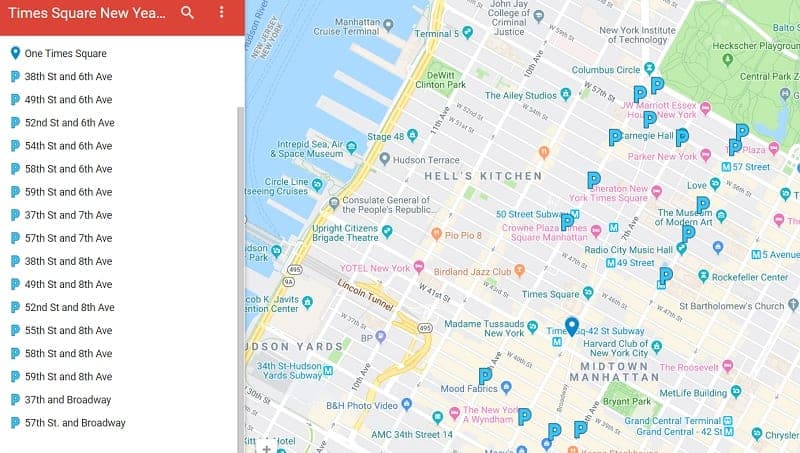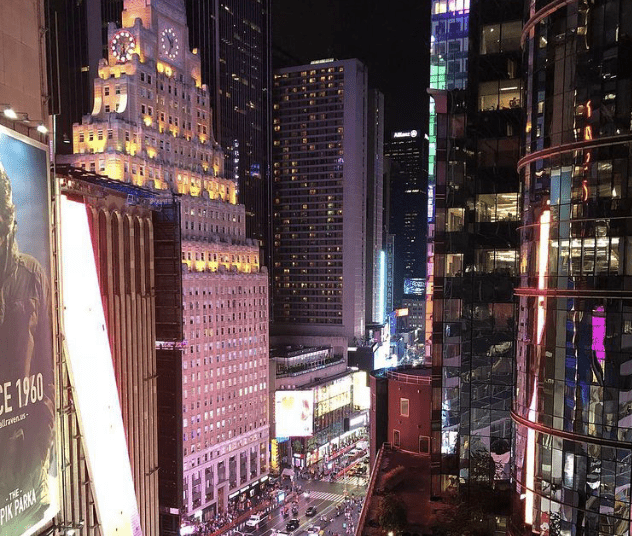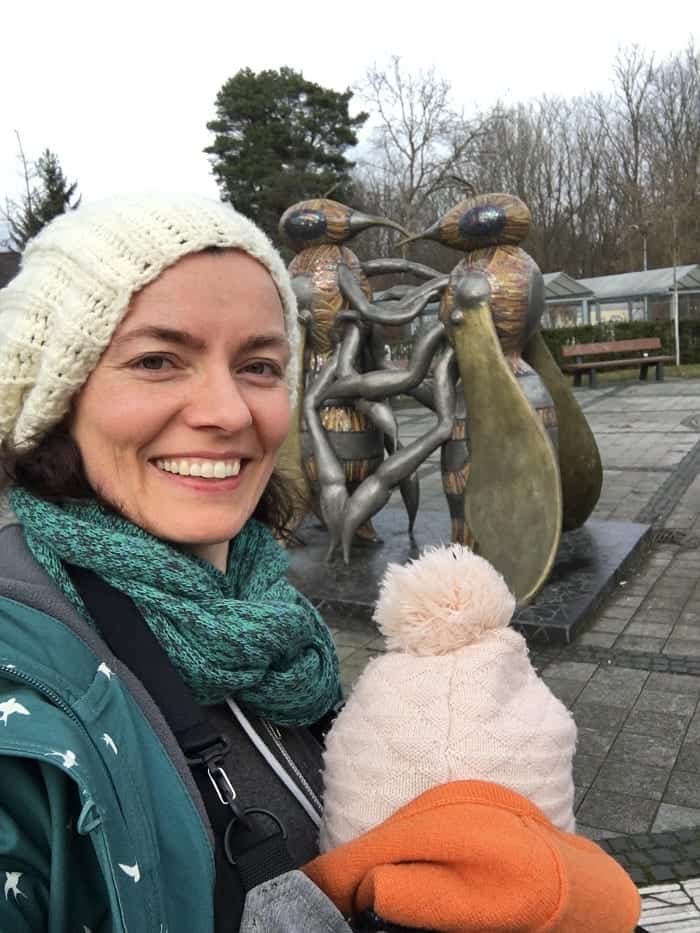Unsere Stadtführer waren alle mindestens einmal beim „Ball Drop“ am Times Square dabei, als eine Kugel (Zeitball) heruntergelassen wurde, und wir können bestätigen, dass es ein unvergessliches Erlebnis ist – was auch immer es verheißen mag!
Im Folgenden teilen wir mit euch unsere Informationen aus eigener Erfahrung, damit die kostenlose Silvesterfeier am Times Square am 31. Dezember 2023 für euch zu einem fantastischen Erlebnis wird!
Wir sagen euch, wo man hingehen muss, um die beste Sicht zu haben, wann man dort sein sollte, was man sich von dem Ereignis erwarten darf, und wir geben euch vier Insider-Tipps und weitere unerlässliche Informationen, damit ihr die Nacht wohlbehalten übersteht!
Dann lasst uns die Party in Schwung bringen!
- Wo man die beste Sicht hat
- Unsere Insider-Tipps
- Wichtige Infos
- Weitere Unterhaltungsangebote zu Silvester in NYC
- Die Geschichte des Ball Drop
- Weihnachten in NYC
DIE BESTE SICHT AUF DEN BALL DROP
Die Kugel wird von 1 Times Square an der 42nd Street knapp südlich der Kreuzung Broadway und 7th Avenue in Midtown Manhattan heruntergelassen.
Der Bereich, von dem aus man den Ball sehen kann, ist recht gross.
Man sieht die Kugel entlang Broadway von der 43rd Street bis zur 50th Street.
Man kann die Kugel auch entlang der 7th Avenue von der 43rd bis zur 59th Street sehen. Je niedriger die Strassennummern sind, desto näher zur Kugel befindet man sich.
Man hat die Kugel auch von der nordwestlichen Ecke des Bryant Park, an der 42nd Street und 6th Avenue, im Blick.

In dem Bereich werden Absperrungen errichtet und man gelangt dann nur an bestimmten Eingängen hinein.
Diese befinden sich entlang der 8th Ave, der 7th Ave, am Broadway und auf der 6th Ave. (Wie auf der Karte oben zu sehen.)
Ausgewiesene Zugänge:
- 6th Avenue - 38th, 49th, 52nd, 54th, 58th, 59th Street
- 7th Avenue - 37th, 57th Street
- 8th Avenue - 38th, 49th, 52nd, 55th, 58th, 59th Street
- Broadway - 37th, 57th Street
TIPP 1 – Frühzeitig hinkommen
Die Kugel gleitet um Mitternacht herunter, wie wir wissen, aber es gibt auch Live-Auftritte und ein Unterhaltungsprogramm, das um 18 Uhr beginnt.
Man muss zu keiner bestimmten Zeit hinkommen, aber wenn man einen guten Platz mit Sicht auf die Kugel bekommen will (siehe unten), sollte man versuchen, vor 15 Uhr oder so dort zu sein.
Falls ihr die Gegend vorher erkunden wollt, bevor ihr euch einen guten Platz sichert, benutzt unseren Führer für den Times Square und Umgebung.
Denjenigen, die am späten Nachmittag/frühen Abend eintreffen werden, empfehlen wir einen Eintrittspunkt an der 6th Avenue statt an der 8th Avenue oder dem Broadway.
Die Zugänge an der 6th Avenue führen auf die 7th Avenue, die gerade ist und eine direkte Sicht auf die Kugel bietet.
Wenn ihr auf der 8th Avenue oder am Broadway eintretet, werdet ihr nicht so gut hinsehen, denn der Broadway liegt diagonal.
Zudem kann man, wenn man auf der 7th Avenue nach Süden (in Richtung der Kugel) blickt, mitunter das Feuerwerk im Central Park sehen, wenn man sich von der Kugel abwendet.
TIPP 2 – Die beste Sicht hat man im „Bowtie“.
Die beste Sicht hat man in dem Areal, dass das „Bowtie“ genannt wird (wo sich der Broadway und die 7th Avenue kreuzen). Diese Zone wird sich zuerst füllen.
Die Hauptzone oder der „beste” Zuschauerbereich liegt zwischen der 42nd und der 48th Street, wo man die Kugel beim Heruntergleiten beobachten und auch die riesigen Bildschirme an 1 Times Square gut sehen kann.

Fernsehbildschirme werden auf den Strassen weiter im Norden errichtet (wo man meist keine direkte Sicht auf die Kugel hat).
*Für Menschen mit Behinderungen gibt es einen ausgewiesenen Zuschauerbereich an der 44th Street und Broadway.
Der Zutritt ist über die 44th und die 6th Avenue mögliche. Zu beachten ist, dass dieser Bereich am frühen Nachmittag bereits voll sein wird, geht also früh hin.
Wenn ihr die Künstler bei ihren Auftritten aus der Nähe sehen wollt, dass müsst ihr euch in der Nähe der Bühne am Broadway Plaza zwischen der 45th und der 46th Street befinden.
TIPP 3 – Meidet die U-Bahn-Station Times Square.
Der Bereich wird irgendwann am Nachmittag von der 6th bis zur 8th Avenue gesperrt.
Seht auf der offiziellen Website des Times Square nach oder folgt der Times Square-Twitter/X-Feed. Dort findet ihr die Informationen zu den Strassensperren.
Nachdem die Strassen gesperrt wurden, könnt ihr die U-Bahn an der 42nd Street und am Times Square nicht mehr verlassen. Seht euch an, welche Haltestellen gesperrt sein werden.
Sucht euch stattdessen eine U-Bahn-Station, die sich nördlich oder südlich vom Times Square befindet. Ausweich-Stationen sind:
- Rockefeller Center Station (Züge B, D, F und M)
- Grand Central Station (Züge 4, 5 und 6)
- Penn Station Station (A, C und E)
Seht euch die nützlichen Tipps in unseren Blogbeiträgen zur U-Bahn an:
TIPP 4 – Keine Panik, falls ihr keinen Zutritt zum Zuschauerbereich bekommt
Falls ihr so spät eintrefft, dass ihr nicht mehr in den Zuschauerbereich hineinkommt, keine Panik. Es gibt in dem Viertel Restaurants und Bars, die den Countdown mit Sicherheit im Fernsehen mitverfolgen werden.
ihr glaubt, nicht (rechtzeitig) hinzukommen, seht euch die sonstigen Veranstaltungen und Unterhaltungsangebote zu Silvester an.
Es gibt auch so NYE Parties (Silvester-Partys) am Times Square, die eine tolle Sicht auf die Silvester-Kugel bieten:
Eine exklusive VIP-Party findet im St. Cloud, der Dachterrassenbar des Hotel Knickerbocker statt, die nur 150 Fuss unterhalb der Kugel am Times Square liegt!

Im Renaissance New York Times Square Hotel gibt es eine feierliche Silvestergala mit Panoramablick auf den Ball Drop.
Das New York Marriott Marquis veranstaltet eine VIP-Party in der 8. Etage des Hotels, das eine fantastische Aussicht bietet.
Geld sparen mit einem Tourist Discount Pass
Bevor wir uns den anderen wichtigen Silvester-Informationen zuwenden, fragen wir uns, ob ihr vielleicht wie wir auch Geld sparen wollt in NYC.
Mit einem Tourist Discount Pass bekommt ihr ermässigten Eintritt zu den meisten der beliebtesten Sehenswürdigkeiten von NYC.
down. Falls ihr in der Stadt mehr als nur Silvester und Neujahr feiern wollt, und viel unternehmen wollt, könnte eines dieser Touristentickets eine gute Wahl sein, um die Kosten der Besichtigungen gering zu halten.
Weitere wichtige Informationen
1. Warm anziehen. Ihr werdet mehrere Stunden im Freien sein, und die Temperaturen können im Dezember unter null Grad liegen.
2. Wenn ihr dann im offiziellen Zuschauerbereich seid, werdet ihr bis Mitternacht dort bleiben. Der Bereich wird irgendwann am Abend abgeriegelt, sodass man ihn dann bis nach dem Heruntergleiten der Kugel nicht mehr verlassen kann.
3. Es gibt KEINE ÖFFENTLICHEN ODER MOBILEN TOILETTEN AM TIMES SQUARE! Die Restaurants lassen euch nicht hinein, nur um die Toiletten zu benutzen.
4. Achtet auf eure Sicherheit in der Menschenmenge, indem ihr eure Taschen verschlossen hält und eure Portemonnaies und euer Bargeld verborgen aufbewahrt. Behaltet eure Umgebung im Auge und achtet auf Taschendiebe.
5. Nehmt davor eine sättigende Mahlzeit zu euch und nehmt Kleinigkeiten zu essen mit, denn ihr solltet euren perfekten Platz für den Ball Drop nicht mehr verlassen, da ihr ihn mitunter nicht wieder erreichen werdet.
6. Trinken in der Öffentlichkeit ist am Times Square verboten, auch wenn es Leute geben wird, die sich nicht daran halten werden. Die Polizei hat allerdings ein wachsames Auge und konfisziert auch gerne mal jedermanns Alkohol.
7. Die Mitnahme grosser Taschen oder Rucksäcke ist untersagt. Alle Taschen werden durchleuchtet, wenn man nach dem Errichten der Absperrungen eintrifft.
8. Der genaue Zeitplan für Silvester 2024 ist noch nicht bekanntgegeben worden, aber wir vermuten, dass er dem vom letzten Jahr sehr ähnlich sein wird:
- 18:00 bis 18:03 Uhr – Die Kugel am Times Square wird beleuchtet und in die Höhe gehoben.
- 18:04 bis 23:58 Uhr – Musik- und Tanz-Vorführungen und Unterhaltungsprogramm der Gastgeber.
- 23:55 bis 23:58 Uhr – eine besondere Musikdarbietung
- 23:59 Uhr – Die Kugel am Times Square gleitet in sechzig Sekunden 70 Fuss nach unten
- 24:00 Uhr - Schlag Mitternacht werden die Lichter an der Silvesterkugel abgeschaltet, während die Ziffern des neuen Jahres über dem Times Square aufleuchten. Mehr als eine Tonne Konfetti wird von den Dächern rund um den Times Square versprüht.
- 00:15 Uhr – Die Veranstaltung ist zu Ende und die Menschen verlassen den Bereich.
DIE GESCHICHTE DER VERANSTALTUNG: WARUM DIE FALLENDE KUGEL?
Die Idee mit der um Mitternacht herabfallenden Kugel, die das neue Jahr einläutet, ist aus dem maritimen Brauch entstanden, einen „Zeitball“ von einer erhöhten Stelle zu einem festgelegten Zeitpunkt fallen zu lassen, um den Kapitänen vorbeifahrender Schiffe die Möglichkeit zu geben, ihre Chronometer einzustellen.
Auch die Menschen an Land, die den Zeitball fallen sehen konnten, konnten so ihre Uhren synchronisieren.
Zeitbälle sind auf der ganzen Welt beliebt geworden.
In New York City hatte die Western Union 1877 einen Zeitball auf ihrem Hauptquartier in Lower Manhattan installiert.
Täglich wurde zu Mittag eine Kugel vom Dach fallen gelassen, und diese konnte in ganz Lower Manhattan und draussen im Hafen gesehen werden.
Dadurch konnte jeder seine Uhren und Schiffchronometer synchronisieren, was eine standardisierte Zeit in der Stadt ermöglichte.
Das Fallenlassen einer Kugel zur Ankündigung der Uhrzeit war in Städten auf der ganzen Welt eine gängige Methode.
Daher stammt die Idee vom Fallenlassen einer Kugel als Ankündigung des Neuen Jahres.
Aber warum am Times Square?
Als die New York Times aus dem Finanzviertel an die 42nd Street umzog (und ihr zu Ehren der Bereich in Times Square umbenannt wurde), wollte sie zum Gedenken an den Umzug in die Innenstadt eine grosse Feier veranstalten.
Mehr als 200.000 Menschen versammelten sich für die neue Feier, zu der auch ein Feuerwerk, aber keinen Ball Drop gehörte.
Ein paar Jahre später erhielt die Times keine Genehmigung für das Feuerwerk, daher beschloss man, bei der Feier einen Zeitball zu verwenden, der eine Stange hinuntergleiten und die letzten Minuten bis Neujahr herunterzählen würde.
Der Zeitungsherausgeber Adolph Ochs liess eine Kugel aus Holz und Eisen herstellen, die mit 100 Glühlampen beleuchtet wurde.
Die Kugel, die 5 Fuss im Durchmesser mass und 700 Pfund wog, musste von einem sechsköpfigen Team von Männern an einem Seil hochgezogen werden.
Der Ball schloss beim Berühren des Daches einen Stromkreis, der daraufhin ein Schild beleuchtete, auf dem das Neue Jahr anzeigt wurde und ein Feuerwerk startete.
Der erste Ball Drop fand am 31. Dezember 1907 statt, um das Jahr 1908 zu begrüssen. Im Lauf der Jahrzehnte wurden mehrere verschiedene Kugeln verwendet.




